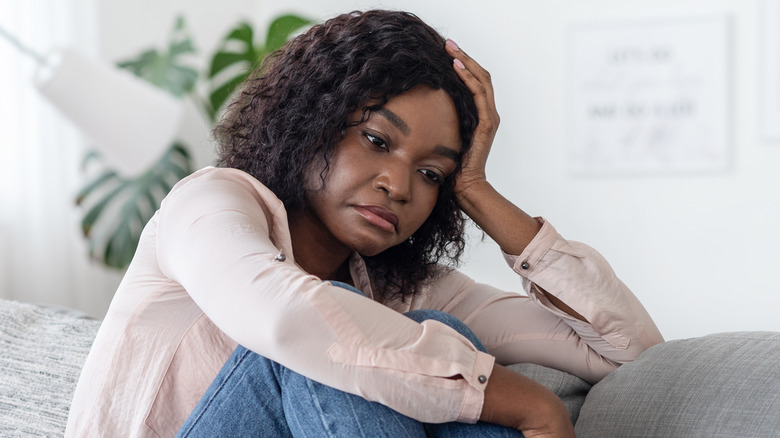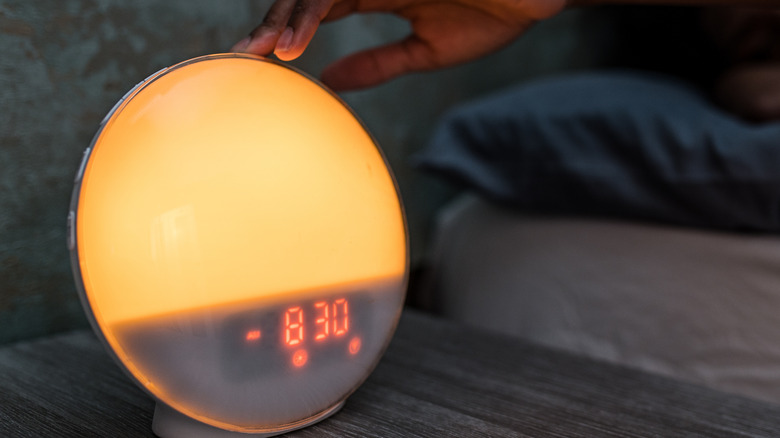Could The Autumn Months Be Causing An Uptick In Your Anxiety?
You've pulled out your knit sweaters and replaced your iced coffees with toasty pumpkin spice lattes. You know what this means: fall has arrived. The days are becoming shorter, and the temperatures are getting colder. For most people, the lack of sunlight can lead to the winter blues, a term characterized by decreased energy and a lower mood. This transition between seasons can be especially concerning for those who experience seasonal depression or seasonal affective disorder (SAD). However, another phenomenon often occurs during this time of year and specifically occurs during the transitional months leading up to winter. Although not an official diagnosis, autumn anxiety has become increasingly common and the symptoms seem to occur annually (via Healthline).
Autumn anxiety may precede seasonal affective disorder; however, the symptoms of autumn anxiety resemble generalized anxiety more than depression. So, how do you know if you're experiencing autumn anxiety? Let's take a look at some key symptoms and what you can do about them.
What are the symptoms of autumn anxiety?
Many people feel dread as the hot summer months slip into a cold autumn chill. The new season signals the end of beach days and poolside lounging, so it's easy to understand how falling leaves can put a damper on your mood. It turns out that the changing seasons can affect more than just your mood. According to Healthline, typical symptoms of autumn anxiety can also include stress, fear, more worrying than usual, quick changes in your mood, lethargy, and general sadness.
The symptoms of autumn anxiety also seem to bleed into those of seasonal affective disorder, such as loss of interest in regular activities, depression, and fatigue. This can help explain the cause of autumn anxiety, as it appears that dread, fear, and depressive symptoms can form in anticipation of winter and the loss of sunshine, per The Healthy. There can be many reasons you may be experiencing autumn anxiety, however, which leads to the issue of addressing your symptoms. If you can relate to any of the listed symptoms above, you should understand that autumn anxiety is common and can be managed.
How to manage your symptoms
Depending on the severity of your symptoms, there are several courses of action you can take to reduce your symptoms. To navigate this transitional time, it is helpful to make note of the changes in your environment, which can contribute to your stress and anxiety. For instance, the lack of sunlight — and a lack, therefore, of vitamin D — can cause the body to produce less serotonin. The decrease in serotonin and increase in melatonin, the chemical that induces sleep, can disrupt your body's circadian rhythm and affect your mood, according to Harvard Health Publishing. To combat the lack of sunlight, try waking up early to get some sunshine. You can also use a light box, which mimics the light of the sun, which can make waking up in the morning easier, per Empowered Health Institute.
As the weather gets colder, you may also feel reluctant to exercise. The lack of movement, however, can make it difficult for you to regulate your mood. Exercising for 30 minutes per day is enough to improve your mood and energy levels (via Healthline). If you're still struggling, reach out to a health professional such as a counselor so they can help determine any underlying causes of your anxiety and work with you to create a plan to manage your symptoms. Regardless of the cause, it's best to address your autumn anxiety as soon as possible so you can return to your everyday activities and make the best of the season before the real cold sets in.


